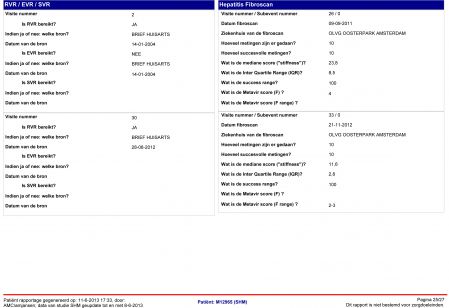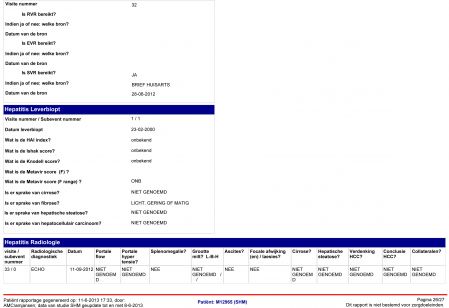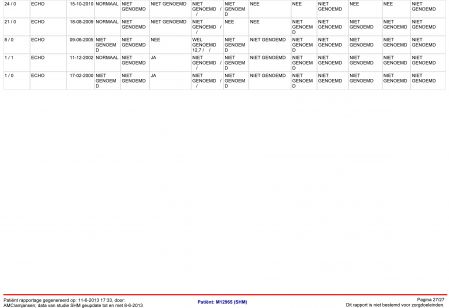Implementation of new HIV and viral hepatitis monitoring success

Since 1 January 2013, all hepatitis-related data from the entire group of patients with chronic HCV infection (N = 1468) has been processed and registered. Anna Jansen is a data monitor at SHM. She is responsible for managing the import of all hepatitis-related changes in the data sets of the SHM database. In the following article shehepatitis describes how SHM has, within a very short time, successfully implemented the monitoring of hepatitis co-infection, liver morbidity and liver diagnostics in HIV-infected individuals.
Monitoring HIV/hepatitis co-infection
The effects of hepatitis B (HBV) and hepatitis C (HCV) co-infections on HIV infection and the effectiveness of treatment of these co-infections has been registered and monitored by SHM since 1 July 2012. In this way, contributions are made to the quality of HIV care and to the anti-viral treatment of viral hepatitis. Furthermore, SHM contributes to research about the treatment of HIV and HBV/HCV co-infections. Since 1 June 2013, SHM also monitors the liver diagnostics of the entire registered HIV-infected population.
Prior to this period, the monitoring of HBV and HCV was limited by SHM. However, there was a need from the physicians to expand the data collection of hepatitis-related data, and as a result a hepatitis working group was formed in March 2010. This group, a collaboration between the NVHB (Dutch Association of HIV-treating Physicians) and SHM, presented a proposal to the SHM on 1 July 2012 to expand data collection on the course and treatment of HBV and HCV in HIV-infected individuals.
Implementation of the new data collection
The new HIV/hepatitis data collection was started as a pilot in July 2012. The expanded collection is related to diagnostics, liver morbidity, anti-HBV and anti-HCV treatment and response to this. In the database, space has also been created for the registration and monitoring of treatment with new medicines. Since 1 January 2013, all hepatitis-related data from the entire group of patients with chronic HCV infection (N = 1468) has been processed and registered. This would not have been possible without the commitment of 10 SHM hepatitis data collectors. Following an intensive training, the hepatitis data collectors visited the 26 HIV treatment centres. Facilitated by the data collector at each treatment centre, the medical history of co-infected patients was reviewed again and all hepatitis-related data was collected and entered into the database. These patients will continue to be followed with the collection of hepatitis and HIV-related data.
Guaranteeing the quality of the collected data
The data entry of patients is largely manual, due to the variety of electronic patient files and record keeping in the various hospitals. Through using specialised data collectors, SHM is able to pay optimal attention to the quality of the data collected. With regard to laboratory results, automation is possible. To this end, SHM has introduced LabLink, an automated link that allows laboratory data from various hospital computer systems to be entered directly and anonymously into the SHM database. The LabLink system is now operational in 8 hospitals, 4 hospitals are in the testing phase and will follow during the course of 2013, and a further 8 hospitals will begin with the testing phase in 2013. SHM is committed to realising the automatic link in all HIV treatment centres.
Future developments
By automating the collection of laboratory results, SHM can go into further depth in other areas and realise quality improvements, as has recently been done in the area of liver diagnostics. From 1 June 2013, liver diagnostics have been structurally and retrospectively registered for not only the hepatitis/HIV co-infections but for the entire patient population. These diagnostics include liver-related radiology results, fibroscans and liver pathology reports. The experience gained through collecting hepatitis data for the co-infected patients has helped us in doing this for the entire population. SHM strives to have the registration of all liver-related diagnostics for the entire patient population completed for the Monitoring Report 2014.
Providing feedback to physicians
In order to give feedback to physicians, SHM’s reports have also been optimized for HBV and HCV. Via SHM’s online reports, it is possible to gain an overview of registered data for a particular patient (see example below) as well as an overview at the hospital level (Centre Specific Reports) that enables benchmarking of that treatment centre. Through this service, SHM offers more insight into the HIV patient population and quality of the HIV treatment centre compared to the national average. In addition, the SHM works jointly with the NVHB/SHM hepatitis working group to analyse the data and publications to contribute not only to the quality of care, but also to broaden the knowledge of HIV and HBV/HCV co-infections.

Figure 1: screenshot from the patient report

Figure 2: screenshot from the patient report

Figure 3: screenshot from the patient report
